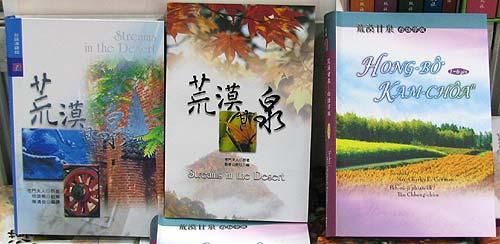Another discovery at the recent book show was that the Taiwan Church Press has issued three editions of Streams in the Desert: one in a Mandarin translation in Chinese characters, one in a Taiwanese translation in a mixed orthography (mainly Chinese characters, with some romanization), and one in Taiwanese completely in romanization.
Streams in the Desert, a book of devotionals, was written in English by Lettie Cowman, better known as “Mrs. Charles E. Cowman.” Her husband was the founder of the Oriental Missionary Society, which today goes by the name of OMS International. The Cowmans did missionary work in Japan in the early twentieth century.
A representative of the press told me that for every ten copies of the Mandarin version, the company sells two or three of the mixed-script Taiwanese version and one copy of the fully romanized Taiwanese edition.
The fully romanized version sells mainly to people who want to learn Taiwanese rather than those who already speak it, he told me. Its recent publication was an experiment, he added. But I forgot to ask the obvious: Does the press consider the experiment a success?

(from left to right: mixed-script Taiwanese, Mandarin in Chinese characters, and fully romanized Taiwanese)

The picture quality isn’t so good on my screen, in the Taiwanese version, what’s at the end of chôa ? Is that a hook? Superscript n?
Is Tainwanese roman part of unicode? I seem to recall some unique accents (a verticle line above vowels) that superscript n …
The best way to further romanization (if that’s your goal) is to produce lots of stuff for children to read and keep it up as they get older. If 99.99 % of written media is in one writing system, people will prefer it even if it’s difficult time-consuming etc. When there’s a lot of material in more than one system, more people will start to go for the more efficient system (whichever that turns out to be).
It’s a superscript n (see this close up), which is quite common in the “church” romanization for system for Taiwanese.
Unicode superscripts covers n at 207F hex (ⁿ in decimal format): x?. But font coverage and browser implementation are another matter. I’d like to do more on Taiwanese romanization; but so far Mandarin is keeping me pretty busy. From the standpoint of how the superscript n appears on a Web page, it’s important to watch that it doesn’t throw off the line height (i.e., make sure lines with superscript n’s don’t have more space above them than lines without superscript n’s).
Furthering romanization is indeed one of my goals. I quite agree of the importance of reading material for youngsters and adults. To this I’d add that it’s important, too, that the material reflect a wide range of topics and be associated with more than pedagogy or marginal concerns. For example, an association with elderly rural people is weighing down the teaching of Taiwanese. Also, I think it’s important that romanization be presented on its own rather than appear interlinearly or any other way that makes it appear a mere adjunct to characters rather than a full writing system of its own.
On options in Romanization:
I personally I don’t like the superscript n following the vowel, I suppose if it co-occurs with tones then representing it with a tilde over the vowel is out of the question (though in this case, of course ch?a is possible to print. Maybe a spanish n-tilde for nasalization?
As for Hanyu, I don’t know mandarin, but I’ve copied some longer hanyu texts into word and fiddled around with them. I think that not marking level tone and either a) marking zero tone (maybe vietnamese style sub-script dots?) or not differentiating between level and zero tone looks far better and less cluttered than marking level tone.
Finally, I used to know an applied anthropological linguist involved in minority language literacy projects. He said the single most important thing isn’t to produce materials, but to train _authors_. Once someone’s written a book in a language (or in a writing system) they’ll do the work of getting it printed and getting other people to read it. To that end, a creative writing workshop in Pinyin (no characters allowed) might be an option worth looking at.
Michael, after some lobbying on our part, Unicode now has full coverage for all glyphs in the Church/Missionary romanization system (see this chart). Specifically we’ve had to ask for a new code point now going by the name of Combining Dot Above Right (U+0358) to represent the dot on the upper right corner of o/O. Frankly dealing with diacritics isn’t as easy as dealing with none, but in fairness Chinese characters are a lot more complicated to learn to read or write with.
What worries me in the long run is not the lack of reading materials — we’re quite good with that. It’s the steady but observable decline in the language among the young over the last two decades. The pace at which this is occurring is, of course, not nearly as bad as that of Hakka or the Austronesian Taiwanese, but the decline doesn’t appear to be abating, either. While books like Streams in the Desert can help, I see a need for much more broad-based investment in programs that would encourage young parents to bring up their children in a mother-tongue-friendly environment.